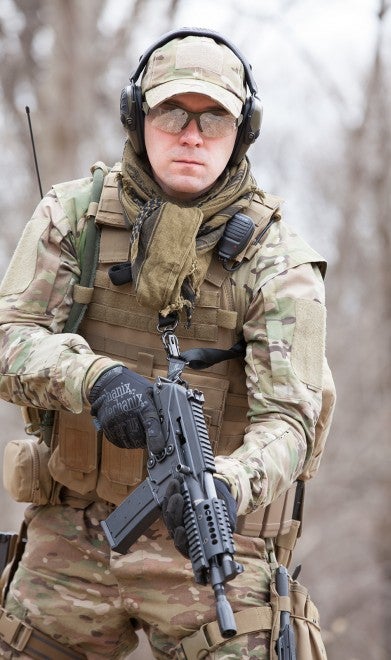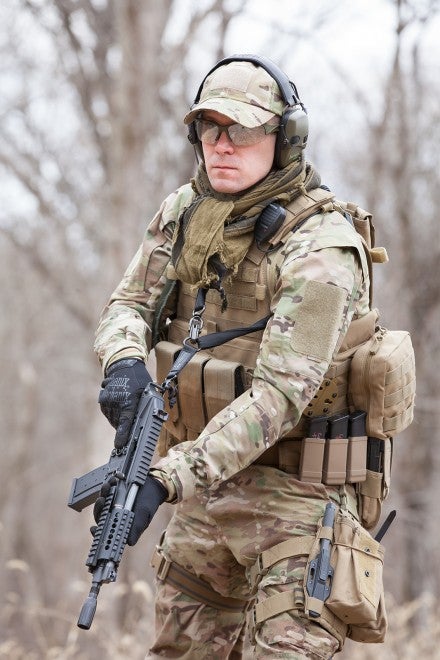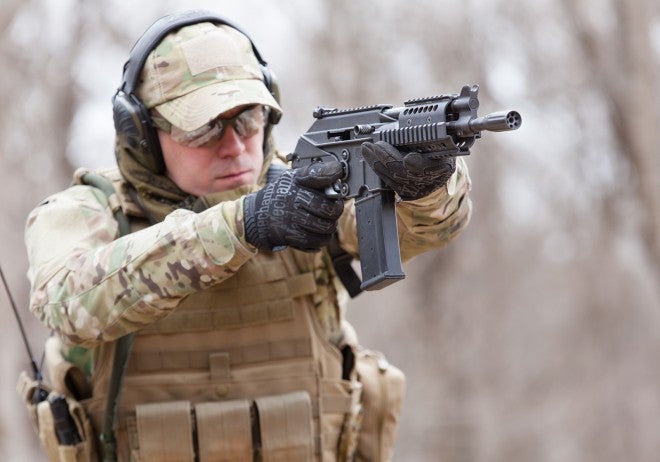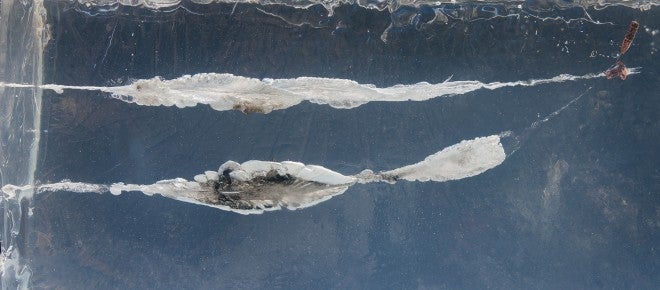Comparative Performance of Three Rifle-Caliber Pistols, Part 1: PLR16
Oleg Volk 02.23.15

Table of Contents
- Comparative Performance of Three Rifle-Caliber Pistols, Part 1: PLR16
- Comparative Performance of Three Rifle-Caliber Pistols, Part 2: Spike’s Tactical ST15-LE
- Comparative Performance of Three Rifle-Caliber Pistols, Part 3: Arsenal SAM7K
Recent interest in pistols based on rifle actions has been spurred, no doubt, by the availability of wrist braces and their incidental utility as stabilizers. No one sane would use such a device for self-defense as it would be slow to attach and rather difficult to set down after the incident. When the police shout, “Put down the gun!” and you fail to drop the attached pistols, you could get shot.
But the semi-rigid rubber contraption could be held against the chest or (until ATF’s arbitrary reversal of their own ruling) shoulder. Being a bigger fan of bullpups than of such pistols, I originally dismissed them as loud, awkward, and ballistically compromised, but an opportunity to test them side-by-side was too good. My friends and I went to the range with one in each of the common calibers: PLR16 in .223, Spike’s ST15 in .300 BLK and Arsenal SAM7K in 7.62×39. Each of these guns has been customized a bit, so the test reflects non-stock configurations.
PLR16 is the lightest of the three at 3.5lbs base weight. As shown with Midwest Industries forend, it weighs 4.2lbs empty or 5.15lbs with 30rds of 55gr ammunition. In pistols, the difference in weight between .22 and .30 caliber becomes significant. It is a short stroke piston design with a 9.5″ barrel. Notch rear sight is set back quite far, which gives it an impressive sight radius and quick acquisition. The forend was added mainly for the eventual mounting of a light/laser and a red dot. While Kel-Tec ships it with a flush-fitting 10-round magazine, PLR16 can take anything from a 20-rounder to a 150-round Armatac drum. The threaded barrel made for a quick and easy installation of a Kew Valley Precision linear compensator, essentially a forward-facing blast diffuser. That made firing a great deal less concussive to the shooter.
Pistols like this are generally carried on slings. The same tensioned sling is used to steady the pistol for firing.
We found that all three guns were well capable of one-inch groups (we ran 5-shot strings) at ten yards and that the accuracy was limited by the steadiness of the shooter. All three would do better at long range if equipped with red dot sights and shot from sandbags, but we only shot them hand-held and with irons. Short-barreled rifles have a massive advantage here, but unfortunately they remain heavily regulated.
Felt recoil is minimal. In stock configuration without the heavier forend, PLR16 can be fired fairly easily with one hand like the old 1896 “broomhandle” Mauser.
Now, let’s talk about effectiveness. One of the common sayings about .223 pistols is that they are not much more effective than 22LR due to the velocity loss. That’s a bit of an exaggeration. A 40-grain 22LR even from an 6″ barrel seldom breaks 1100fps, while heavier 55-grain .223 exceeds 2400fps from the 9.5″ tube of the PLR. The difference in construction also shows, with jacketed bullets performing rather better than plain or plated lead. The confusion comes with the “requirement” that M193 (55gr) and M855 (62gr) FMJ fragment upon impact, which doesn’t happen below 2700fps. While those loads are still quite effective absent fragmentation, I’d like to look at the far more numerous options available to non-military users.
I did not test all possible .223 cartridges on the market, only enough to verify that effective loads are possible. 55gr Remington soft point impacted at 2410fps, penetrated 13.5″ and expanded to about .3″. 62gr Remington bonded soft point hit at 2170fps and stopped after 11″, also expanded to .3″. By comparison, 32ACP ball from the tiny Kel-Tec P32 hit at only 870fps and created an 11″ long, .3″ wide wound track that started out at full width of the bullet. However, 32ACP doesn’t actually come close to .223, even from a shorter pistol barrel. For one, the permanent tissue stretch cavity was much more extensive with .223. For another, 32ACP is stopped by almost any armor, as well as auto bodies or glass.
We tested a pistol rated Dyneema hard plate that stopped 7.62×25 FMJ against PLR16 with 55-grain FMJ. The result: full penetration. We re-tested with 55-grain soft point with the same result. We even tried a 45-gain L-Tech frangible range ammunition against the plate, again with full penetration. Two-thirds of the frangible bullet got past the barrier, expanded slightly, and penetrated 11″ into the gel, albeit without extensive cavitation along the way. Essentially, it performed like a .22LR bullet once past the armor.
We also tried G2 65-grain all-copper HP that performed very well previously in a 12.5″ SBR. The curved path shows the bullet flipping over twice but not expanding. 2200fps proved insufficient. On the other hand, the double yaw and 17.5″ overall penetration depth are worth something even without expansion. Overall, I would recommend bonded soft points for .223 pistols, provided they feed reliably. If your pistol does not feed them, look at plastic-tipped hollow points like Winchester Silvertips. The same soft points, incidentally, do not work as defensive loads from longer barrels. Fired from a 16″ rifle, both 55 and 62 grain loads fragmented explosively, penetrating less than 6 inches.
Besides the penetrating ability, .223 is also far easier to shoot at longer ranges. At 100 yards, a bullet from even a long-barreled .22 revolver would drop 17-18 inches, while .223 ball would only drop 3.5 inches. When aiming at small to medium game, this is a significant difference. In defensive use, the somewhat awkward handling of the larger pistols is compensated by the increased power and the ability to shoot one-handed. While body armor use among violent criminals is uncommon, .223 does much better than most pistol calibers in defeating auto glass and sheet metal. Relative to the 7.62/.300 handguns, PLR16 has the advantage of much lighter weight of both the weapon and the ammunition for it. It is also pleasantly inexpensive compared to other options.
To be continued with 7.62×39 and .300 Blackout test results…



